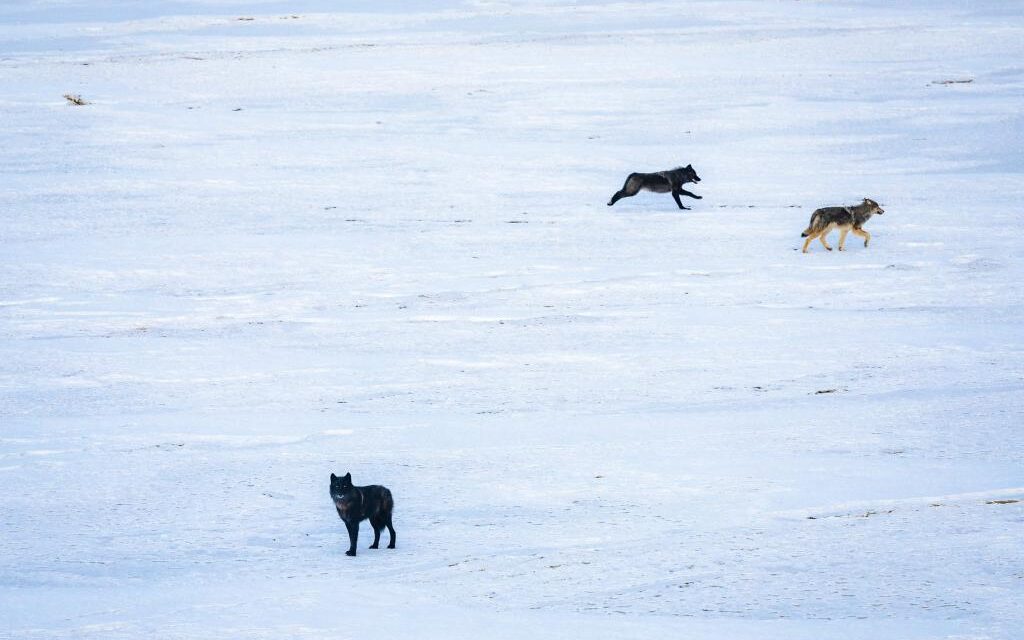DENVER — On Saturday, Colorado Parks and Wildlife (CPW) completed capture and release work for the second gray wolf reintroduction season in support of the Colorado Gray Wolf Restoration and Management Plan. Fifteen wolves were translocated from the central interior of British Columbia to Colorado. Separately, the agency also successfully completed the release of five members from the original Copper Creek Pack. All wolves were released in Eagle and Pitkin counties, continuing the agency’s efforts to create a permanent, self-sustaining gray wolf population in Colorado. No further releases are planned for the 2024-2025 capture season. This is the second of three to five release seasons of wolves.
CPW has a responsibility to balance the safety of staff and the animals with the level and timing of information provided during this complex wildlife operation. Unfortunately, staff safety was threatened as CPW offices were watched and threatening social media posts and phone calls were received. Two of the ten wolves reintroduced in 2023 have been illegally shot. The gray wolf in Colorado is protected by the federal Endangered Species Act (ESA) and state law. Penalties for illegal take can vary and include fines up to $100,000, jail time and loss of hunting privileges. Because of the safety risk and security needs of our staff and the animals, CPW did not share wolf release details while the operation was underway.
British Columbia Operation
Over the course of six days wolves were captured in British Columbia and released in Colorado. Seven males and eight females were translocated.
Wolves were captured from areas in British Columbia where predator reduction is occurring to support caribou recovery. Colorado Parks and Wildlife was responsible for all costs associated with the capture and transport of these gray wolves and there was no compensation or payment for the wolves themselves. The British Columbia government undertook engagement and consultations with First Nations in the areas where wolves were identified for capture. Three First Nations were represented in the planning and operational phases of this project.
The capture, transport and holding of the wolves was authorized under British Columbia’s Wildlife Act. The export of wolves from British Columbia to Colorado is permitted under the Convention on International Trade in Endangered Species of Wild Fauna and Flora (CITES), administered by the Canadian Wildlife Service.
Animal welfare and safety was prioritized throughout all stages of the project and followed an approved Animal Care Plan. The translocated wolves received a high level of veterinary care; were vaccinated and collared. Unfortunately, one wolf passed away following its capture. An examination was conducted by onsite veterinary staff and noted that the animal’s age and underlying condition may have contributed to the death.
CPW biologists were careful to select wolves that met the criteria identified at the outset of the program. Wolf selection followed the guidance of the Colorado Wolf Restoration and Management Plan. Animals with major injuries — such as several nonfunctional canines, missing eyes, fractured or missing limbs — or mange or lice infection were not chosen for reintroduction. Gray wolves from this area of B.C. do not overlap with areas where livestock are present, so there are no concerns that the wolves selected have been involved in repeated livestock depredations.
In British Columbia, CPW worked closely with a team from the B.C. Ministry of Water, Land and Resource Stewardship (WLRS) to capture the gray wolves. CPW biologists, veterinarians and wildlife officers flew to Prince George, B.C., in January and met with B.C. biologists, veterinarians, wildlife officials, and helicopter capture crews. The full team assembled after the January 8, 2025 Colorado Parks and Wildlife Commission meeting and began capture operations in the Canadian province 48 hours later.
Temporary pens were built to hold the animals while waiting to be flown to Colorado. Each pen contained hay (for bedding) and ice blocks (for a water source) for the animals while the team worked to capture wolves for each flight back to the United States.
After ensuring that the captured wolves were good candidates for translocation, biological samples of the animals were collected as part of standard protocol. In addition, the wolves were given treatments for internal and external parasites. Wolves were vaccinated against rabies, canine distemper virus, canine adenovirus, canine parainfluenza virus, and canine parvovirus.
Before transport, the 15 wolves were placed in individual crates with hay and an iceblock for the flight from B.C. to Colorado and then transported to the release sites. CPW staff were on board to monitor the wolves’ health throughout the flight. The transport of the wolves to Colorado was made possible by LightHawk, a conservation-focused organization that utilizes aircraft. LightHawk’s volunteer pilot donated over 30 hours of turbine aircraft time to facilitate the movement of the 15 wolves to Colorado.
Appropriate permits and inspections were conducted at the airport prior to transport to the Pitkin and Eagle County release sites. There are no USDA/USFWS quarantine requirements for reintroduction of wolves. All animals were issued a Health Certificate from a British Columbia veterinarian.
CPW released five wolves in Colorado on each of three dates: Jan. 12, 14 and 16 in Eagle and Pitkin Counties. CPW worked to release the animals as expeditiously as possible post-capture in British Columbia. Due to lengthy travel times from British Columbia to Colorado and border inspections, all three releases occurred during the evening. The January 12 date, coincidentally, marked the 30th anniversary of wolves first being reintroduced from Canada to Yellowstone National Park.
“This binational effort was conducted by a professional team of experts from two jurisdictions,” said CPW Director Jeff Davis. “From the veterinarians and biologists to the helicopter pilots and wildlife officers, this team worked together to ensure a safe and successful outcome for this year’s capture and release efforts that also prioritized the health and safety of staff and animals.”
“It has been an honour to work with Colorado Parks and Wildlife staff to support their conservation priority. It is a great example of collaboration and the connections we have in the large landscapes of North America” said Hillary Ward, Regional Director of Resource Management with the B.C. Ministry of Water, Land and Resource Stewardship
British Columbia has an abundant gray wolf population, estimated to be in the range of 5,300 to 11,600 animals. They are widely distributed throughout the province and their status is not currently considered to be a conservation concern.
Copper Creek Operation
On January 18, CPW successfully relocated the Copper Creek female and four pups. CPW wildlife veterinarians evaluated the health status of the female and the four pups while at the secure facility where they had been since late August and early September 2024 and determined that they were in good condition.The pups were released with the female to ensure that they learn to hunt. This gives the animals the best chance at survival, furthering the goal of successfully restoring wolves in Colorado. Each animal was fitted with a collar for tracking after release. The wolves were then placed in crates and transported to a release site.
All five animals are collared and will be closely monitored. This agency decision to re-release the Copper Creek animals considered multiple factors, including the health of the animals, the timing of the B.C. releases this year and the potential proximity to new wolves on the landscape. This strategy gives the animals the best chance for survival, advancing Colorado’s gray wolf restoration efforts.
“As I said at the time, options in the case of the Copper Creek Pack were very limited, and this action is by no means a precedent for how CPW will resolve wolf-livestock conflict moving forward. The male adult wolf was involved in multiple depredations. Removing the male at that time, while he was the sole source of food and the female was denning, would likely have been fatal to the pups and counter to the restoration mandate,” said Davis.
The capture of the pack was a management action that was taken to change the behavior of the animals to reduce depredations and could further impact the adult female’s behavior moving forward.
The expanded and improved capabilities the agency has available for producers this year through the Conflict Minimization program will allow for faster response to conflicts and higher likelihood of effective non-lethal deployment. This work results in improved strategies for altering depredation behavior early and reducing the potential for repeated depredations.
“I want to express my sincere thanks to the CPW teams involved in these efforts in both British Columbia and Colorado, and the team from the British Columbia Ministry of Water, Land and Resource Stewardship, LightHawk, and many others for their partnership and expertise in this historic conservation effort,” said Davis.
“As restoration efforts continue, CPW is committed to working with livestock owners, communities, state agencies and all partners to reduce the likelihood of wolf-livestock conflict. Our goal is to keep ranchers ranching, while at the same time restoring a healthy, sustainable population of gray wolves to Colorado as mandated,” said Davis.
# # #





